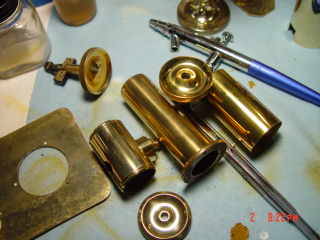
-----
Creating a rich gold hue finish on polished brass
I'm restoring a beautiful brass Victorian microscope. It's previous owner butchered its finish by taking it to a buffing wheel and doing a good job of damaging its finish. I have repaired the damage, but am now faced with the problem of restoring its original finish. The brass, when polished possesses a very light gold hue. The original hue possessed a darker, richer, warmer golden tint. I've spent a great deal of time experimenting with time and temperature in an effort replicate the original appearance, but to date have achieved only limited success in that I have failed to obtain consistent results with the various pieces of the microscope. I believe this to be due to variations in the mass and alloy composition differences between the various components. This leads me to believe some chemical may have been used to darken the brass. I may be wrong though; Time and exposure to light might have been responsible for the wonderful effect. My observation is that the lacquer applied was not tinted. I have tried using a tinted lacquer without success.

The photo will (I hope) assist in helping you to see what I speaking of in relationship to the inconsistent hues between the various components you see. The middle and right hand "cylinders" were heat treated and possess very much the original hue. The left hand cylinder is only polished. The flat plate to the left of the left hand cylinder was heat treated, but as I hope you can discern, the color is much different than the middle and the right hand cylinder even though it was heat treated in the exact same manner. I sincerely hope that this photo assists you in forming a basis for much needed advice.
My question to you is this; Is there a chemical treatment known to create the "golden" darkening effect I desire to obtain or is there perhaps an oil combined with heat treatment that I should consider? How about extended UV light exposure? Should I mention neutron bombardment?
VERY MUCH looking forward to hearing from you... or anybody else out there who might hold an answer to my question.
- Santa Barbara, California
2003
2003
Golden yellow colour on brass:
sodium thiosulphate
⇦ on
eBay
or
Amazon [affil link]
......240 gm
copper acetate [affil link]...........25 gm
water....................1 litre
citric acid
⇦ on
eBay
or
Amazon [affil link] ..............30 gm
solution temperature.....35-40 °C
Thiosulphate and acetate are dissolved in water,add citric acid before use.Article ( clean and degreased)is immersed in cold solution,then series of lustre colours is produced in the following sequence:golden yellow-orange-brown-purple-blue-pale grey. Finished object may be lacquered or wax coated.
- Zagreb,Croatia
Q, A, or Comment on THIS thread -or- Start a NEW Thread